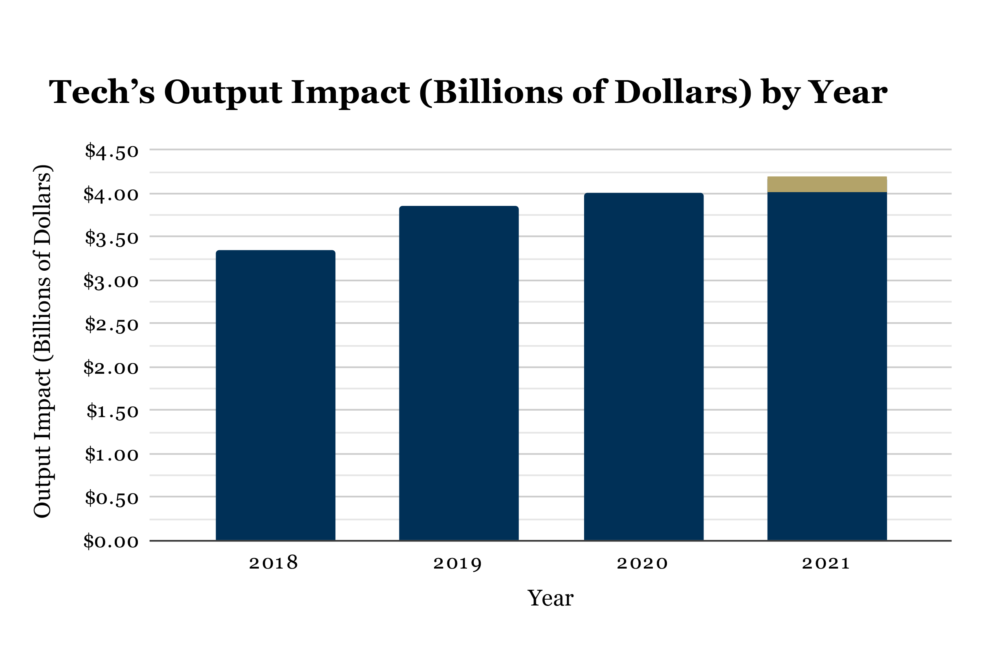The University System of Georgia (USG) annually publishes a document that analyzes the economic impact that Georgia’s higher education institutions had on the state during the previous fiscal year (FY).
The Board of Regents of the USG wanted to provide the public with “tangible evidence of the economic linkages between the academic community and the community as a whole because, traditionally, the benefits are discussed in broad, qualitative terms.”
Thus, they commissioned the Selig Center for Economic Growth at the University of Georgia’s Terry College of Business to prepare the report.
Their findings for FY 2021 were released in May 2022. The economic observations featured in the study took place from July 1, 2020 to June 30, 2021 and examined the impact of research universities, comprehensive universities, state universities and state colleges — a total of 26 schools. Private universities and colleges are not included within the USG and are therefore not included in the report.
The research was spearheaded by Dr. Jeffrey M. Humphreys, the director of the Selig Center at UGA.
Overall, “the total economic impact of all 26 institutions on their host communities was 19.3 billion in FY 2021.” In FY 2020, this number was 18.7 billion — totaling to around a six hundred million dollar increase.
According to the study, this “output impact” was captured by combining the initial spending by the institutions and the students with the induced or re-spending (multiplier) effect.
“Of the FY 2021 total, 13.1 billion (68 percent) is initial spending by the institutions and students; 6.2 billion (32 percent) is the induced or respending (multiplier) impact,” the annual USG economic impact report explains.
Moreover, the USG’s institutions added a total of 152,629 full and part-time jobs. Nearly one third of these job openings are on-campus, with the rest being off-campus in either the private or public sector.
Notably, it was reported that “the 152,629 jobs generated by the USG equal 3.4 percent of all nonfarm jobs in Georgia.”
The report further explains, “[To look at this number from a different angle], that would translate to about one employee per 29 people. This would also total to the number of positions at Georgia’s top five employers – Fort Benning, U.S Army Signal Center and Fort Gordon, Walmart, Delta Air Lines and Emory University.”
This figure is on par with the number recorded in the report for FY 2020; during the previous year, USG added 155,010 full and part-time jobs to the state. These jobs accounted for around 4% of all nonfarm jobs in Georgia.
Of the numerous achievements obtained during FY 2021 by USG institutions, Tech’s contributions to the local economy are noteworthy.
It was reported that the Institute added more to Georgia’s economy than any other institution housed under the USG. Tech’s output impact — the total increase in business sales revenue — amounted to nearly 4.2 billion dollars. For comparison, it was around four billion in FY 2020, which means that the Institute experienced a 4.6% increase within the year.
Over half of that money stems from personnel services; meanwhile, the other portion can be attributed to operating expenses and student spending.
Furthermore, Tech added a value of around 2.9 billion dollars to the state.
Not only did the Institute outperform every other USG school in this regard, but it also narrowly beat the record it set for itself in FY 2020, when Tech’s value added impact was nearly 2.8 billion dollars.
Tech’s presence also generated an abundance of jobs, totaling up to 28,000 new employment opportunities. 9,256 of those jobs were on-campus, and 18,849 were off-campus jobs due to institution-related spending.
This number is consistent with that of FY 2020.
The researchers involved in the study say that “these economic impacts demonstrate that continued emphasis on colleges and universities as pillars of the state’s economy translates into jobs, higher incomes, and greater production of goods and services.”
All in all, the study tells a positive story for each institution, and Tech is no different.
Its efforts to bring forth an innovative environment has contributed to the state’s economy in a way that only a premier technology institute can.
For a more in depth review of this study, refer to usg.edu/ assets/usg/docs/news_files/ USG_FY_2021_Economic_ Impact.pdf.
One may also contact Humphreys at [email protected] for specific questions.
